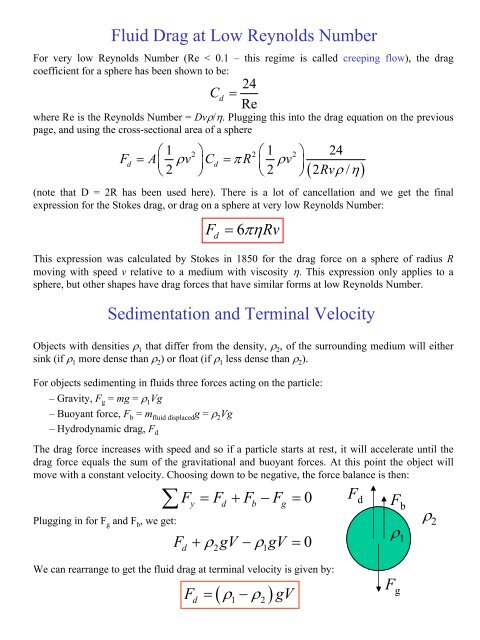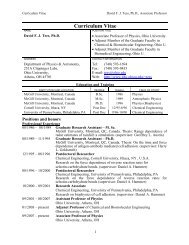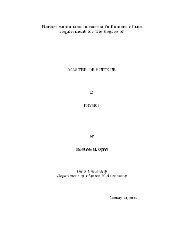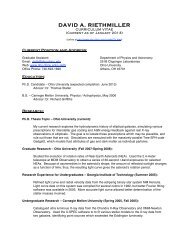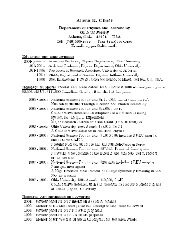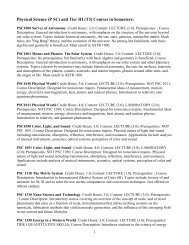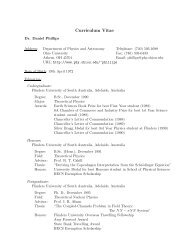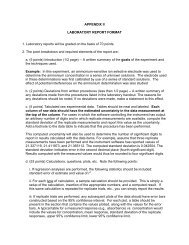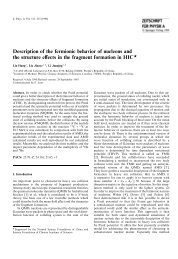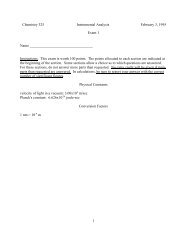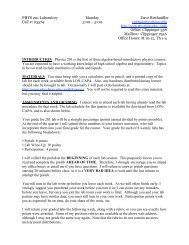Fluids in Motion Supplement I
Fluids in Motion Supplement I
Fluids in Motion Supplement I
You also want an ePaper? Increase the reach of your titles
YUMPU automatically turns print PDFs into web optimized ePapers that Google loves.
Fluid Drag at Low Reynolds Number<br />
For very low Reynolds Number (Re < 0.1 – this regime is called creep<strong>in</strong>g flow), the drag<br />
coefficient for a sphere has been shown to be:<br />
C<br />
d<br />
=<br />
24<br />
Re<br />
where Re is the Reynolds Number = Dvρ/η. Plugg<strong>in</strong>g this <strong>in</strong>to the drag equation on the previous<br />
page, and us<strong>in</strong>g the cross-sectional area of a sphere<br />
⎛1 2⎞ 2⎛1 2⎞<br />
24<br />
Fd<br />
= A⎜ ρv ⎟Cd<br />
= πR ⎜ ρv<br />
⎟<br />
⎝2 ⎠ ⎝2 ⎠ 2 /<br />
(note that D = 2R has been used here). There is a lot of cancellation and we get the f<strong>in</strong>al<br />
expression for the Stokes drag, or drag on a sphere at very low Reynolds Number:<br />
Fd<br />
= 6πη<br />
Rv<br />
This expression was calculated by Stokes <strong>in</strong> 1850 for the drag force on a sphere of radius R<br />
mov<strong>in</strong>g with speed v relative to a medium with viscosity η. This expression only applies to a<br />
sphere, but other shapes have drag forces that have similar forms at low Reynolds Number.<br />
Objects with densities ρ 1 that differ from the density, ρ 2 , of the surround<strong>in</strong>g medium will either<br />
s<strong>in</strong>k (if ρ 1 more dense than ρ 2 ) or float (if ρ 1 less dense than ρ 2 ).<br />
For objects sediment<strong>in</strong>g <strong>in</strong> fluids three forces act<strong>in</strong>g on the particle:<br />
– Gravity, F g = mg = ρ 1 Vg<br />
– Buoyant force, F b = m fluid displaced g = ρ 2 Vg<br />
– Hydrodynamic drag, F d<br />
( Rvρ η)<br />
Sedimentation and Term<strong>in</strong>al Velocity<br />
The drag force <strong>in</strong>creases with speed and so if a particle starts at rest, it will accelerate until the<br />
drag force equals the sum of the gravitational and buoyant forces. At this po<strong>in</strong>t the object will<br />
move with a constant velocity. Choos<strong>in</strong>g down to be negative, the force balance is then:<br />
∑ Fy = Fd + Fb − Fg<br />
= 0 F d F b<br />
Plugg<strong>in</strong>g <strong>in</strong> for F g and F b , we get:<br />
F + ρ gV − ρ gV =<br />
d<br />
2 1<br />
0<br />
ρ 1<br />
ρ 2<br />
We can rearrange to get the fluid drag at term<strong>in</strong>al velocity is given by:<br />
Fd<br />
( ρ ρ )<br />
= −<br />
1 2<br />
gV<br />
F g


